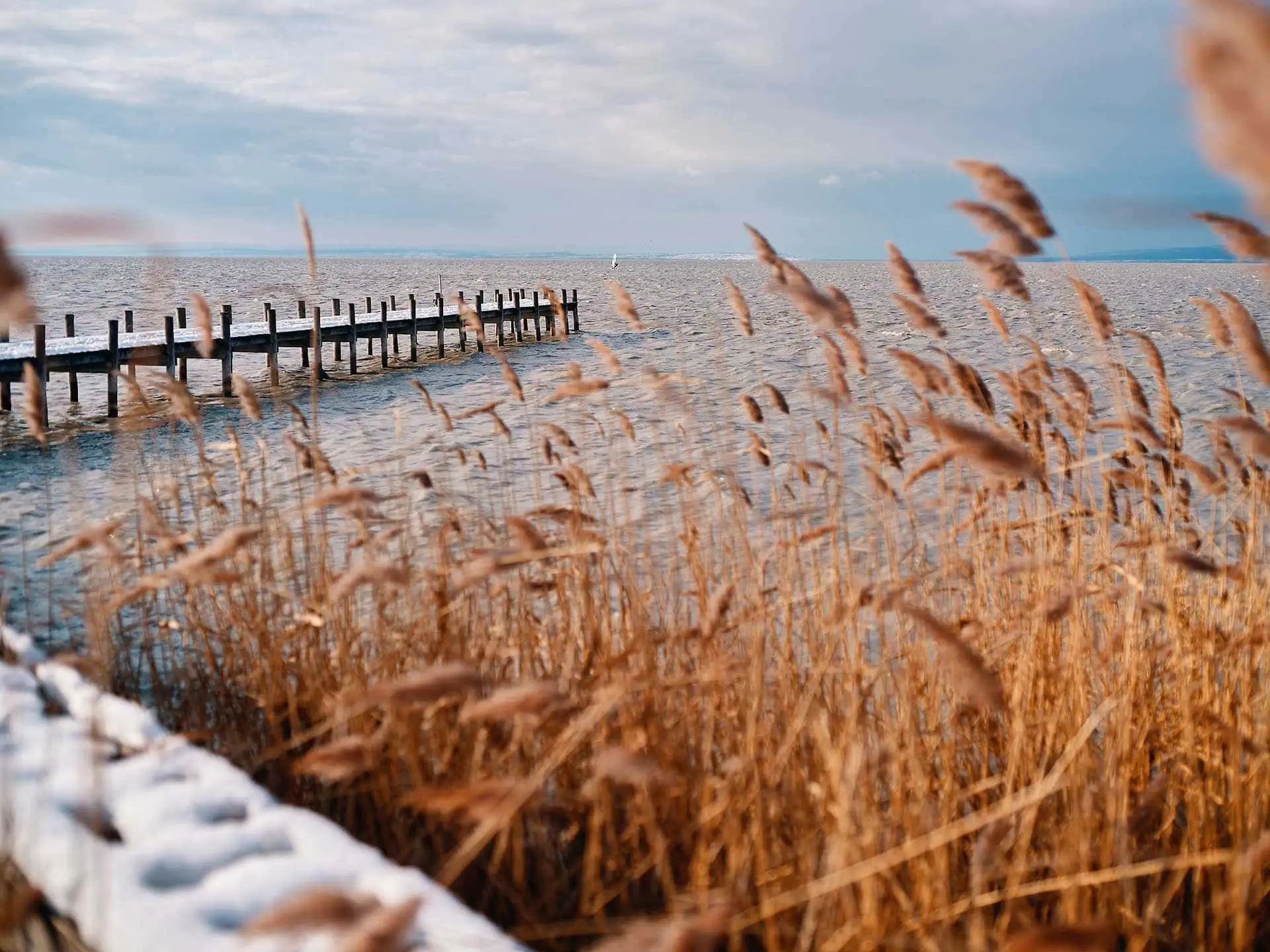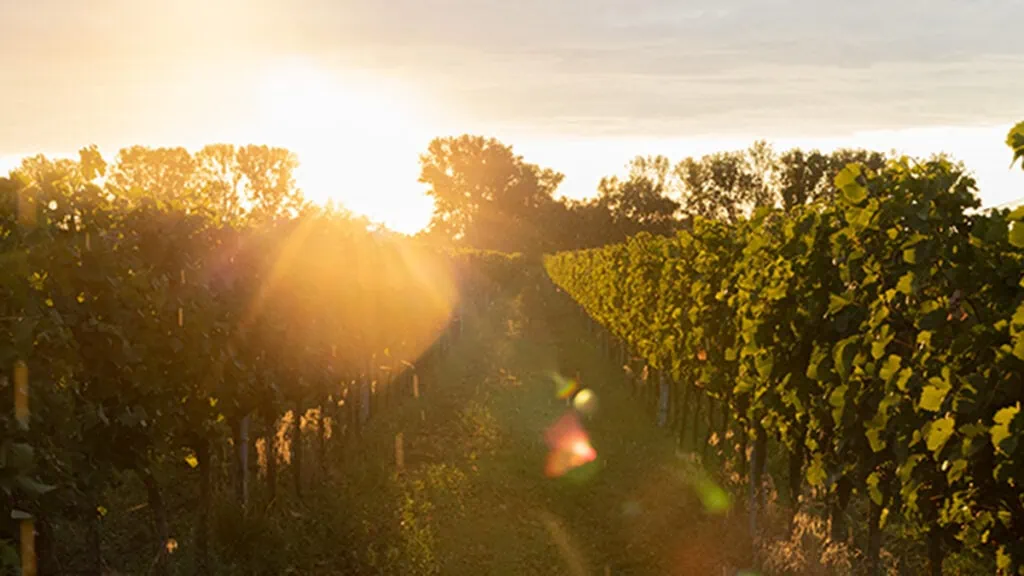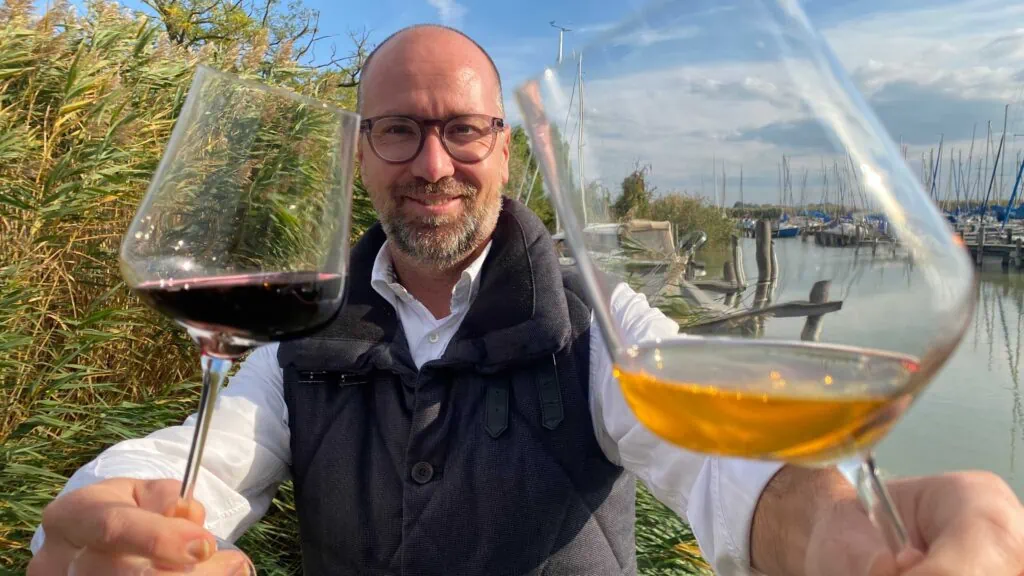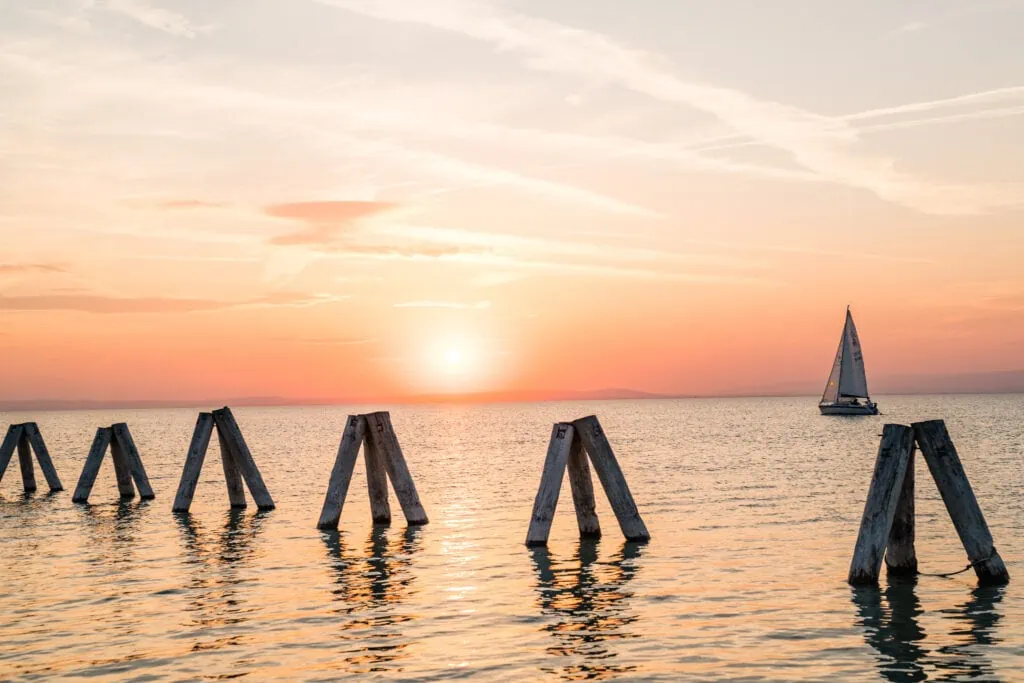
The sun in the logo says it all: Burgenland is Austria’s proud “sunshine state”. As a winegrowing region, the Neusiedlersee DAC origin benefits from a “cool climate”. This may sound like a contradiction, but it’s actually quite the opposite.
Supported by the federal government, the federal province and the European Union.
Leafing through Burgenland’s brand guide, you soon come across a description of how the region’s current logo evolved. After all, the region is proud of not just the successful design, but also the inspiration behind the province’s modern emblem: the sun. The following extract sums it up perfectly:
“With around 300 days of sunshine a year, Austria’s youngest province is rightly referred to as the ‘Land of Sunshine’. This is why the sun also serves as the symbol for the new Burgenland brand. Now in the province’s colours of red and gold, the trademark with the stylized sun symbol symbolizes the broad spectrum of Burgenland’s diversity and refers to attractions in Burgenland aesthetically and appealingly. Anywhere you see the sun, you can be sure of quality from Burgenland.”
And it’s true that Bruckneudorf in Burgenland – which is situated at the point where the DAC regions Carnuntum, Leithaberg and Neusiedlersee meet – comes top of the list as by far the sunniest place in Austria. This small community of around 3,000 residents is located to the north of Neusiedlersee (Lake Neusiedl). Over the past 30 years, the sun has appeared here for an average of 2,053 hours annually!

Radiant sun, cool climate
This beaming sunshine is the stuff of dreams for both tourism and also sunseekers who are looking to indulge in the region’s award-winning wines. It also gladdens the heart of the Neusiedlersee DAC winegrowers, as they can rely on an extraordinarily unique environment. Their wines benefit from an unmistakable origin and soak up the rays of sunlight in this cool location.
However, how is it at all possible for a region like Austria’s “sunshine state” to be known as an origin with a cool climate? “Basically, it’s all about not confusing the weather with the climate, or not putting them on an equal footing,” observes Torsten Aumüller, Managing Director of the Neusiedlersee DAC region of origin.

Understanding terms correctly
Aumüller continues: “As far as wine is concerned, a ‘cool climate’ doesn’t refer to a vineyard on the North Sea coast, for example. Rather, wine regions are named an origin with a cool climate if they fulfil certain, distinctly stipulated criteria.” Specifically, while the vines are growing, the temperature must be between 13 °C and 15 °C. There must also be definite differences in temperature between night and day, and clearly defined seasons with warm summers that have a high level of precipitation, frosty winters and dry autumns. Austria as a whole ranks alongside the winegrowing regions of Germany, Switzerland, Champagne, Loire Valley (both France), and also parts of the USA and Canada, as regions with an especially expressive cool climate.
All these criteria apply to the Neusiedlersee DAC region of origin as well – which is confirmed by facts obtained from the Climate Change Centre Austria: The annual mean air temperature in Burgenland is 11.0 °C, ranging between below 9 °C in the Güns Mountains and almost 12 °C around Lake Neusiedl.

Neusiedlersee DAC: Cool climate with unique microclimate
It is the cool climate in a global context and the predominant microclimate that give the Neusiedlersee DAC wines of origin – and others besides – their special quality, continues Aumüller. “As the lake acts as a heat reservoir in the summer, it cools the surrounding vineyards gently and evenly at night.” These circumstances are unique beyond the borders of Austria as well. Deputy Chairman of the Neusiedlersee DAC region of origin, Andreas Nittnaus, gives a detailed explanation: “The long hours of sunshine and the associated weather stability are also due to the large expanse of water. It creates a thermal that acts like a quite natural weather barrier.” Sommeliers agree that the interaction of these and other components leads to “fresh wines that can taste so compact, and dense wines that are so light”.
Cool climate creates special taste
On the subject of taste: This cool climate ensures that the wine is imbued with special characteristics. “The aromatics and particularly the acidity of the grapes benefit from long maturation times and an alternation between warm days and cool nights,” explains Gerhard Retter, one of the most renowned sommeliers in German-language countries. His colleague Alexander H. Ultes specifies: “Wines from cool climate regions have fruit that generally seems fresh; they are aromatic with a fine range of acidity, yet still fully matured thanks to the stable weather conditions during ripening until harvesting in the autumn.” However, wines from cooler global climes have long been enjoyed by the general public as well. An extract from German magazine “Eat Smarter” reads: “The change in temperature enables less sugar to be stored in the grapes. This creates a fresh fruitiness with balanced acidity – producing a reduced alcohol content with dry wines.”


Stable weather as distinct feature
While these ascriptions apply more or less to all cool climate regions throughout the world, the Neusiedlersee DAC region can lay claim to a very special characteristic due to the interaction between sun and lake. “The lake is not just responsible for less precipitation and therefore more hours of sunshine, it also ensures a rare stability in the weather,” remarks Andreas Nittnaus. This benefits grape health as it allows less mould to develop, and other diseases are less able to take hold as well.
However, the situation is rather paradoxical: While these circumstances guard against aggressive diseases, it is noble rot – of all things – that feels especially at home here. Nittnaus: “The microclimate around Neusiedlersee (Lake Neusiedl) generates a combination of lovely autumnal weather and misty autumn mornings. These are ideal conditions for Botrytis cinerea, or noble rot, which is needed for the production of high-quality sweet wines.” The wines referred to are Beerenauslese and Trockenbeerenauslese, for which winegrowers such as Andreas Nittnaus are incidentally envied by experts from the Tokaji and Sauternes regions every year: “We know from discussions with winegrowers from other sweet wine regions that the lake enables a far more stable noble rot than the rivers in other botrytis areas.”
In a nutshell: The lake constantly balances the climate on its shores and helps the sky to maintain its deep blue colour for a maximum length of time. This ensures that not only Zweigelt and sweet wines – which are regarded as specifically typical of the Neusiedlersee DAC region – are equipped with the necessary finesse every year afresh, bringing a smile to the faces of winegrowers and wine enthusiasts alike – just like the sun itself. This is how unique wines of origin are created. From Austria’s sunny side of cool. For the enjoyment of all.
THE VITICULTURE CLIMATE ZONES:
Cool climate
European regions in this zone include northern France (Beaujolais, Burgundy, Champagne and Loire), Germany, Austria and Switzerland. The average temperature in these regions is below 16 °C. Aromatic white wines from grape varieties that tend to ripen early, but also lighter red wines such as Pinot Noir, for example, are globally typical of such areas.
Intermediate climate
In Europe, this includes Bordeaux and the northern Rhone Valley in France, Rioja in Spain, Tuscany and large areas of northern Italy. The average temperature here is between 16 and 18.5 °C. Predominantly dark, strong red wines are produced here.
Warm climate
From a European perspective, this includes the south of France, the Douro Valley in Portugal, Madeira, southern Italy and large parts of Spain. The average temperature is between 18.5 and 21 °C. These regions are especially predestined for dark, heavy red wines and strong sweet wines.
Hot climate
Regions include southern Greece, Turkey and southern Spain. With an average temperature of 22 °C and above, these areas produce sizeable quantities of table grapes and raisins, besides wine grapes.
The Neusiedlersee DAC. Unique origin wines.
In the Neusiedlersee DAC region, the magnificent power of all the four elements is shown to the full. The earth and the rich diversity of its species are the basis of the region’s wines. For centuries, vines have grown and thrived on this soil. A cooling purity is borne by the air, filtered by the winds from the open Pannonian Basin. With its special lakeside terroir, Lake Neusiedl itself pervades the unique quality of this origin. And the handicraft of the winegrowers, continued throughout the year with an ongoing passion – fire – brings the elements together with attentiveness, expertise and individuality. The fiery enthusiasm displayed by the winegrowers unites them in their winemaking.
___
Neusiedlersee DAC.
Unique Zweigelt. Unique sweet wines.
From the bright side of Austria. For the enjoyment of all.
____



